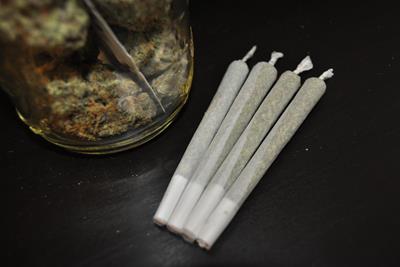
Sunday December 19, 2021
 420 Culture
420 Culture
The rolled cannabis cigarette, most commonly referred to as a “joint,” is among the most iconic staples of all cannabis culture. Naturally, they have become a fundamental offering at dispensaries. However, the joint’s ubiquity has contributed to a fierce debate among cannabis consumers: are pre-rolls worth it? One side decries them as the swindle of the century, a scam to be avoided at all costs, while the other touts them as the height of convenience and a reliable staple. The truth lies somewhere in between.
Why Do People Like Pre-Rolls?
A pre-rolled joint is one of the easiest ready-to-use methods of getting cannabinoids into the body: just light and inhale. This makes pre-rolls incredibly convenient for anyone without the time or skills required to roll a joint. These are likely the two most common reasons that people opt to purchase prerolls. Even seasoned hand-rollers (like the author of this article) will admit to picking up a few at the dispensary if they are headed to an event it will be difficult to roll at, or if they simply don’t have the time.
Another reason that people opt for pre-rolls is to sample new strains without the hassle of buying loose gram, or a desired strain might only be available in a pre-roll (perhaps it is sourced from a different grow, or is the last remnant of a dying strain). It’s often easier to buy infused joints as pre-rolls rather than fortifying your own, as well.
However, be aware that if the intention of a pre-rolled joint is to serve a customer’s need for convenience, then it logically follows that the cost of this convenience will be reflected in the price.
If you see a 1g pre-roll being sold at the same price as 1g of flower, that means the dispensary is absorbing the price of the paper, the tip, and the time it took to assemble these parts together. Thus, to save costs, they might be using cheaper flower. Alternatively, this is the reason that pre-rolls are sometimes higher in price than we may expect.
Think about it this way: logically, a pre-roll should always be more expensive than its constituent parts, or at least as expensive. For many budtenders, laboriously packing joints is an accepted chore of the job, but not a welcome one, because it is tedious, repetitive and time consuming. Dispensary owners pay for that time and labor, and must recoup it in the cost of the pre-roll one way or another, either by saving on costs or charging more.

Those costs will shift depending on the quality of flower, papers, and tips, the cost of labor to fill the joints, and what sort of margins the dispensary needs to cover in between. Some dispensaries may use pre-rolls as a loss-leader in an attempt to get consumers in the door, others will use them as a way to gouge uneducated consumers. Thus, the pricing of pre-rolls in relation to their actual value can sometimes be difficult to assess.
However, your time is also valuable, and paying for convenience might be worth it. In the end, there are many factors whether a pre-roll is a better option than rolling your own, let’s take a look at them in more detail.
What Makes a Good Pre-Roll?
In order to determine if a joint is truly a better value than rolling your own, one simply has to consider if the value of those extra steps is better to be absorbed by oneself or paid to a dispensary. And remember, needs may change depending on context. Here’s what to consider:
Flower Quality
The primary determinant of joint quality is flower. One reason some prefer to roll their own is to know exactly what’s going into their smokes. Joints from a dispensary can be filled with top-shelf nugs or shake (the remnant pieces of flower and leaves), and sometimes everything in between.
This isn’t necessarily a bad thing, depending on the deal you’re getting on the joint, and what you’re hoping to get out of it. Sometimes a big cheap joint hits the spot, even if it contains middling-quality weed. Sometimes you just want to try a little of the high-shelf without paying for more.
Though some joints can be filled with trash (sugar leaf, shake and other leftover bits), fear not. Once a more common practice, shake is rarely found in pre-rolls much beyond a pinch these days. In modern markets, the majority of shake or sugar leaf is used for other preparations — typically extracts or edibles — that are able to make quality products out of inferior starting materials thanks to the nature of their production.
Most often, what’s being put into joints is just smaller popcorn nugs (aesthetically undesirable, but still potent and tasty) that have been ground up.

This makes good sense for the dispensary because they are able to make use of a visually unappealing product and still make a return, and makes sense to the customer because they are still purchasing quality flower in a convenient preparation. This is the ideal setup and makes the best value for both business and customer, but isn’t always the case.
Ideally, pre-rolls will be of at least of suitable quality because the dispensary wants you to return and buy more. They are a high-demand item that’s easy to move, and if the dispensary wants to keep selling them, they need people to keep buying them. Every dispensary is different though, as is where they see value.
A dispensary in an area with high tourism might care less about returning customers, and try to upsell their mediocre weed in pre-rolls, knowing that the convenience factor will be more attractive to visitors. Alternatively, a lesser known outfit could be putting top shelf in their pre-rolls to try and set themselves apart from the herd.
In the end, it's best to try and inquire about what flower is used for a dispensary’s pre-rolls. Many will make it a part of their sales pitch, such as “ we only use whole ground flower,” etc. This doesn’t mean that it’s always the truth, but any effort at validating the quality of flower is better than none. You can then decide for yourself if its worth the price.
Grind
Most dispensaries use a food strainer as a grinder. The strainer is filled with flower and set over a bowl, then ground in pestle-and-mortar fashion. The strainer acts as a filter and keeps the stems and seeds out. This allows a budtender to efficiently prep and sift large amounts of flower.
However, this powdery grind doesn’t allow much airflow in the final product, and is the reason that tightly compacted dispensary joints often run or canoe. If you find that your pre-rolled joints aren’t pulling with the same smoothness as your hand-rolled ones, this might be the culprit, yet another factor to consider when purchasing. Many who avoid pre-rolls altogether cite the fact that most of them run as being a reason to stay away.
Paper and Tip/Crutch
Though somewhat ancillary to the high experience, difference in paper materials can greatly affect the overall taste. Many smokers prefer hemp or rice-derived papers to the usual standard joint paper, which is made from woodpulp and flax.
Hemp and rice papers tend to be more costly, and thus do not always wind up being used for pre-rolls. However, many dispensaries have adopted them as the standard. Raw cones are the current industry standard, and are made from hemp. Elements, which are made from rice, tend to have a milder taste and smoother smoke, so if you prefer those, you might want to roll yourself.
Most pre-rolls come with a tip or crutch, however not all do, and some even come with specialty reusable glass tips or crutches. Factor these preferences into your shopping as well.
Time
It takes a few minutes and a stable staging area to assemble joints. If you are short on either, this is where the pre-roll really shines. When you don’t have the time or ability to roll, there value of convenience is much higher. As mentioned earlier, even the most astute joint rollers will turn to pre-rolls if the occasion calls for it. Ask yourself what your time is worth when tallying up the cost of your purchase.
Roll Quality
By this we mean how the joint is formed. Is it uniform throughout? How compact or loose is it? The joints one gets from a dispensary should not have much variance in this property, but actual hand-rolled joints will, until expertise is achieved. Still, it’s important to understand that very few of the pre-rolls one encounters in a dispensary are rolled “by hand.” Usually, budtenders use pre-formed cones to make their joints. Those same pre-formed cones are available to you, often sold at that very dispensary, so if you have the time and relatively good fine-motor control, almost anyone can assemble their own just like the “professionals,” for a cheaper cost.
Hand Rolled vs. Pre-Rolled Joints
If this is your first venture down the joint rabbit hole, I’ll let you in on an interesting secret: a lot of cannabis enthusiasts, budtenders included, can’t hand-roll a joint. And that’s perfectly fine. You don’t need to be an expert joint roller to enjoy cannabis.
Yet, to truly decide if pre-rolls are worth it, we must stop to consider a very important question; can you actually roll a joint? If the answer is, “no, but I’d still like to smoke a joint,” then a pre-roll is the way to go. If you’re really against buying pre-rolls but still haven’t learned how to roll a joint, consider getting a joint roller machine.
Finally, if you do want to get started hand-rolling, just remember that your early joints don’t have to be pretty, they just have to be smokable. The rest will come with practice.
To determine if rolling a joint is worth it or not, simply ask yourself how much each of the factors listed above are worth to you, and compare the cost or value of each to the cost of the joint.
Frequently Asked Questions
Are Pre-rolled Joints Cheaper Than Hand Rolling?
Typically, it is cheaper to roll your own joints, but this will depend on the price of rolling materials in your area, the price of pre-rolls, and the price of loose flower, and your ability to roll. When joints are on sale, they are sometimes the most cost-effective option in the dispensary, but that’s usually because they are nearing the end of their freshness, or are rolled with lower-quality materials. How much value you get from a joint will depend on numerous factors.
Are Pre-Rolled Joints Filled With Shake?
Most pre-rolls are rolled with ground popcorn nugs, however some producers still used shake or other lower-end products. Always inquire with the budtender if there’s any information on what type of flower is used to fill the pre-rolls, and use this to help make your purchasing decisions.
Are Pre-rolls Hand Rolled?
No, the pre-rolled joints that are available in dispensaries are usually machine rolled cones that are filled by hand, but are not “hand-rolled” in the traditional sense. --What do you love or hate about pre-rolls? Sound off in the comments below!
What do you love or hate about pre-rolls? Sound off in the comments below!







